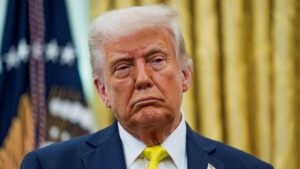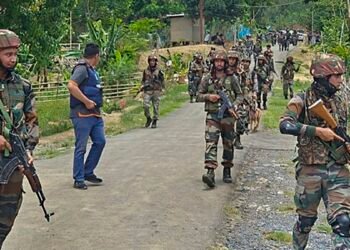Despite 14 bunker-buster bombs hitting the Fordow site, U.S. intelligence reports that the heavily fortified underground facility remains structurally intact. Entrances were sealed, but key centrifuges may still be operational.
BY PC Bureau
On June 21, 2025, the United States executed a significant military operation, codenamed “Operation Midnight Hammer,” targeting three key Iranian nuclear facilities: Fordow, Natanz, and Isfahan. This marked the first direct U.S. military engagement against Iran, escalating the ongoing conflict between Israel and Iran, which began with Israeli strikes on Iranian nuclear and military targets on June 13, 2025. The U.S. operation involved over 125 military aircraft, including B-2 stealth bombers that dropped 14 GBU-57 Massive Ordnance Penetrators (MOPs), commonly known as “bunker buster” bombs, on Fordow and Natanz, and more than two dozen Tomahawk missiles launched from a U.S. submarine targeting Isfahan.
The primary objective, as stated by President Donald Trump, was to dismantle Iran’s nuclear enrichment capacity, which the U.S. and Israel have long claimed poses a threat to regional and global security. The operation was a dramatic escalation, thrusting the U.S. into a direct role in the Israel-Iran conflict, which had already resulted in significant casualties and infrastructure damage on both sides. According to Iranian state media, Israeli strikes since June 13 have killed at least 430 people and injured 3,500 in Iran, while in Israel, 24 civilians have been killed and 1,272 injured.
Impact of the Airstrikes: U.S. Intelligence Assessment
A preliminary U.S. intelligence assessment, reported by Reuters and the Washington Post, indicates that the airstrikes did not achieve the comprehensive destruction claimed by President Trump. Key findings include:
Limited Damage to Nuclear Infrastructure: The strikes sealed off entrances to two of the targeted facilities (Fordow and Natanz) but did not collapse their underground structures. Fordow, Iran’s most fortified nuclear site, buried nearly 300 feet beneath a mountain, was designed to withstand such attacks. Some centrifuges, critical for uranium enrichment, remained intact.
Check out this article: Iran’s Nuclear stockpile intact. https://t.co/K20WImhftM
— Navin Upadhyay (@Navinupadhya) June 25, 2025
Setback, Not Elimination: The assessment suggests that Iran’s nuclear program was set back by only one to two months, far short of a permanent disruption. Iran’s enriched uranium stocks, particularly those at Fordow enriched to up to 60% purity (near weapons-grade), were not eliminated. A senior Iranian source claimed that most of Fordow’s highly enriched uranium was moved to an undisclosed location before the strikes, a claim that could not be independently verified.
No Radiological Impact: The International Atomic Energy Agency (IAEA) reported no increase in off-site radiation levels following the strikes, and Iran’s Nuclear Safety Center confirmed no contamination or danger to nearby residents. This suggests that the attacks did not cause significant damage to nuclear materials that could lead to environmental or health hazards.
Damage Assessment Challenges: The IAEA’s Director General, Rafael Grossi, noted that assessing the full extent of underground damage at Fordow remains difficult. Satellite imagery from Maxar Technologies and Planet Labs showed six bomb entry points at Fordow, indicating severe surface damage, but the status of underground infrastructure is less clear.
READ: Defiant Iran Insists: Nuclear Program Will Resume
The White House rejected the intelligence assessment as “flat out wrong,” maintaining that the strikes significantly “degraded” Iran’s nuclear program. This discrepancy highlights a tension between the administration’s public narrative and the intelligence community’s findings.
President Trump’s Reaction
President Trump announced the strikes on June 21, 2025, from the White House Situation Room, flanked by Vice President JD Vance, Secretary of State Marco Rubio, and Defense Secretary Pete Hegseth. In a televised address and posts on Truth Social, Trump claimed that Iran’s “key nuclear enrichment facilities have been completely and totally obliterated,” describing the operation as a “spectacular military success.” He emphasized that the strikes targeted Iran’s nuclear program, not its people or military, and warned that further attacks would follow if Iran did not pursue peace.
On June 22, Trump reiterated his claims, stating that the strikes had changed history by neutralizing the nuclear threat posed by “the world’s number one state sponsor of terror.” He urged Iran to negotiate a peace deal to avoid additional strikes, warning that “there are many targets left” that could be hit with “precision, speed, and skill.” Israeli Prime Minister Benjamin Netanyahu praised Trump’s “bold decision,” claiming it denied “the world’s most dangerous regime” access to nuclear weapons.
 READ: Donald “Flip-flop” Trump Will Never Cease to Amuse!
READ: Donald “Flip-flop” Trump Will Never Cease to Amuse!
By June 23, Trump escalated his rhetoric, raising the prospect of regime change in Iran. In a post on Truth Social, he wrote, “It’s not politically correct to use the term, ‘Regime Change,’ but if the current Iranian Regime is unable to MAKE IRAN GREAT AGAIN, why wouldn’t there be a Regime change??? MIGA!!!” This statement contrasted with assurances from Hegseth and other officials that the U.S. was not pursuing regime change, indicating a potential shift in policy or rhetorical strategy.
On June 24, the Trump administration adjusted its narrative at the United Nations Security Council, stating that the strikes had “degraded” Iran’s nuclear program, a more measured claim than Trump’s initial assertion of total obliteration. This shift likely responded to the intelligence assessment and international scrutiny.
Iran’s Response and Claim to Resume Nuclear Enrichment
Iranian officials swiftly condemned the U.S. strikes as a violation of international law, the United Nations Charter, and the Non-Proliferation Treaty (NPT). Foreign Minister Abbas Araghchi called the attacks “outrageous” and warned of “everlasting consequences,” stating that Iran “reserves all options” to defend its sovereignty and security interests. At an emergency UN Security Council meeting on June 22, Iran’s ambassador, Amir Saeid Iravani, accused the U.S. of waging war under a “fabricated and absurd pretext” to prevent Iran from acquiring nuclear weapons, noting the irony given the U.S.’s history as the only nation to use nuclear weapons in combat.
Iran’s Atomic Energy Organization declared that the country would continue its nuclear activities despite the attacks, emphasizing that the damage was not significant. Mohammad Manan Raisi, an Iranian MP from Qom (near Fordow), claimed the damage was “only on the ground” and could be restored, a statement echoed by Mehdi Mohammadi, a senior parliamentary adviser, who said Fordow had been evacuated beforehand and sustained no “irreversible” damage.
Iran has maintained that its nuclear program is for civilian energy production, a stance it reiterated after the strikes. However, the attacks have bolstered hardline voices within Iran calling for the resumption or intensification of nuclear enrichment as a deterrent against further aggression. The IAEA has noted that Iran’s uranium enrichment to 60% purity—close to weapons-grade—escalated after Trump’s withdrawal from the 2015 Joint Comprehensive Plan of Action (JCPOA). While U.S. intelligence agencies, including Director of National Intelligence Tulsi Gabbard, have assessed that Iran has not decided to build a nuclear weapon, the strikes may prompt Iran to reconsider its nuclear strategy.
Supreme Leader Ayatollah Ali Khamenei warned that any U.S. military involvement would result in “irreparable damage” to American interests. Iran’s parliament voted to close the Strait of Hormuz, a critical global oil chokepoint, though this decision requires approval from the Supreme National Security Council. Such a move could disrupt nearly a quarter of global oil shipments, potentially causing a spike in oil prices and global economic instability.
International and Domestic Reactions
UN Secretary-General António Guterres called the strikes a “dangerous escalation” and urged a return to diplomacy to prevent a “cycle of destruction.” IAEA chief Rafael Grossi expressed concerns about the potential widening of the conflict and the risk to the global non-proliferation regime. Russia and China condemned the strikes, with Russia’s UN ambassador comparing them to the 2003 U.S. invasion of Iraq. Gulf nations like Bahrain, Qatar, and Kuwait called for de-escalation, while Israel’s UN ambassador, Danny Danon, thanked Trump for acting decisively.
U.S. Domestic Response: The strikes sparked controversy in the U.S., with critics like House Minority Leader Hakeem Jeffries and Senator Bernie Sanders arguing that Trump lacked congressional authorization, violating Article I, Section 8 of the Constitution. Representative Marjorie Taylor Greene, a Trump ally, criticized the strikes, stating, “This is not our fight. Peace is the answer.” Conversely, former Vice President Mike Pence praised Trump’s “decisive leadership.” Public opinion, as gauged by a Washington Post poll, showed 45% opposition to the strikes, 25% support, and 30% uncertainty.
Strategic Implications and Risks
The limited success of the airstrikes, as per the intelligence assessment, raises questions about their strategic value. While the U.S. aimed to degrade Iran’s nuclear capabilities, the survival of enriched uranium stocks and operational centrifuges suggests Iran could resume enrichment quickly. The strikes may have strengthened Iran’s resolve to pursue nuclear capabilities as a deterrent, especially given the precedent of Israeli and U.S. attacks.
Iran’s potential retaliation poses significant risks. Tehran has a history of asymmetric warfare, including proxy attacks through groups like Hezbollah, though the group has indicated it will not join the current conflict. Closing the Strait of Hormuz could disrupt global energy markets, with Brent crude already rising to $78.83 per barrel after the strikes.
Trump’s rhetoric about regime change introduces further uncertainty. While U.S. officials like Hegseth and Rubio have denied regime change as a goal, Trump’s comments could embolden Iranian hardliners and complicate diplomatic efforts. The U.S. and Iran were engaged in talks before the strikes, but Araghchi has since declared diplomacy “not an option” for now.
The U.S. airstrikes on Iran’s nuclear facilities on June 21, 2025, represent a bold but risky escalation in the Israel-Iran conflict. While President Trump claimed the strikes “obliterated” Iran’s nuclear program, preliminary intelligence assessments indicate only a temporary setback of one to two months, with key infrastructure and uranium stocks largely intact. Iran’s commitment to continuing its nuclear activities, coupled with threats of retaliation and potential closure of the Strait of Hormuz, heightens the risk of further escalation. Trump’s shift from claiming total destruction to acknowledging a “degraded” program at the UN Security Council reflects the complexity of the situation, while his regime change rhetoric adds a volatile dimension to U.S. policy. The international community’s call for restraint and diplomacy underscores the need for a de-escalatory approach to prevent a broader conflict with catastrophic consequences for the region and beyond.













